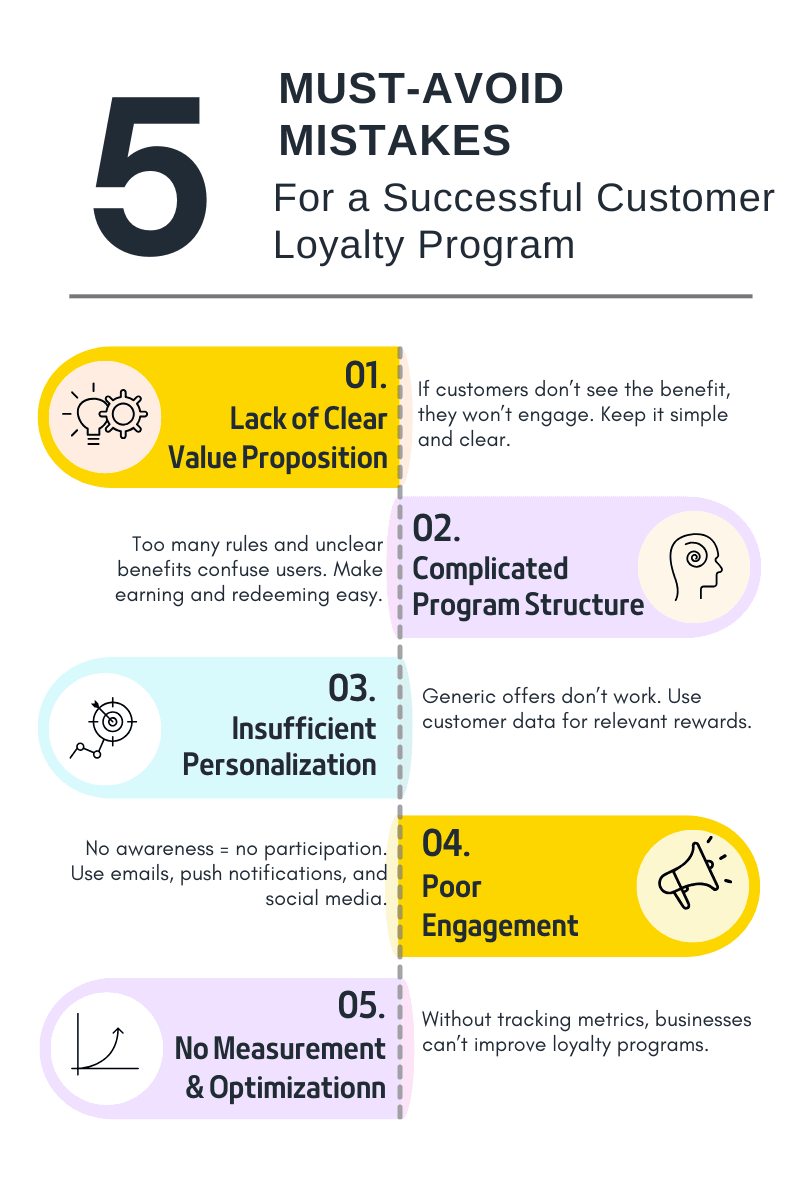Shield Your Customer Brand Loyalty Incentives From These Failures
Building a brand loyalty program comes with many challenges that may have a significant overall impact. However, sticking to crucial points can help mitigate these risks.
Nancy J. Hassler
5 Must-Avoid Mistakes for a Successful Customer Loyalty Program
When business owners face the task of engaging and retaining customers, various types of loyalty programs come to the rescue. However, obstacles in the way of developing and implementing initiatives can have the opposite effect, undermining the brand's reputation and interaction with the audience.
A vivid example is Plenti, the coalition loyalty program launched by American Express in 2015. Despite its strong brand backing and multiple high-profile partners, the program failed to deliver consistent value to users, suffered from weak customer engagement, and lost key partnerships — ultimately shutting down in 2018.
Let's delve into some of the most common mistakes to understand their specifics, detect them on time, and eliminate them successfully.
Why Do Loyalty Programs Fail to Deliver Desired Results?
Brand loyalty programs have long been recognized as a main tool for expanding the customer base and increasing engagement. As Loyalty360 emphasized, the transformation of approaches is driven by the necessity to constantly meet ever-changing customers' expectations, who are aware of the risks of being deceived by misleading promises of savings. However, several barriers hinder the introduction of innovative loyalty approaches, especially in the face of intense competition, which can render them ineffective.
Among the primary challenges is accurately calculating the economic costs. Otherwise, introduced incentives may prove unprofitable. The development and launch of loyalty programs depend on numerous factors, necessitating marketing costs for management, analytics, and technical support. Regular audits and budget revisions ensure sustainable growth and reasonable, profitable spending.
Other pitfalls in creating loyalty programs include low customer awareness, lack of uniqueness, complicated participation rules, and shifting customer priorities. Addressing these issues requires a comprehensive preliminary assessment of potential risks, trend analysis, and an understanding of the overall landscape. This approach will help implement all necessary changes in business strategies.
In their 2022 HBR article, Wharton professor Raghuram Iyengar and co-authors demonstrate how Panera’s “Unlimited Sip Club” subscription—priced at $8.99 per month—often ended up costing the chain more than the revenue it generated when members indulged in frequent refills, highlighting the importance of accurately calculating economic costs before launching loyalty incentives.

Lack of Clear Value Proposition: A Barrier to Building Strong Brand Loyalty
Doomed to failure, implementing solutions devoid of a transparent brand vision and primary objectives tops the list of reasons why loyalty programs fail. A clearly defined mission serves as a driving force for these initiatives, becoming a base for effective business strategies across various formats.
Strengthening Brand Alignment
An explicit goal bridges the gap between the company's values and loyalty program, aligning incentives with the brand's core promises and the paths to achieving them. Aiming to enhance customer relationships, loyalty solutions with an understandable vision and strategy become potent tools for differentiating brands and increasing their resonance with the target audience.
Transparency as a Core
Underpinned by well-defined goals, the company's transparent policy and value system foster trusting customer relationships and deep emotional connections. Open communication through social media, feedback channels, etc., demonstrates the importance of customer opinions and the brand's willingness to address requests.
A Strategic Road Map for Marketers
Understandable strategy and a unified brand mission set the direction for all business strategies, particularly regarding loyalty programs. They facilitate the prioritization of incentives, which is essential for effective financial management and the distribution of marketing efforts. This crucial influence also extends to defining and segmenting the target audience, allowing strategies to be adapted to meet each category's specific needs.
A clear value proposition serves as a hook, highlighting the benefits of loyalty programs to clients. A well-defined brand vision and mission resonate with the audience, helping to expand the customer base and increase engagement.
In 2023, Delta Air Lines drastically overhauled its SkyMiles loyalty program by tying elite status and rewards solely to the amount of money spent, rather than miles flown or flight frequency. This shift alienated many loyal customers, sparked widespread backlash on social media, and forced Delta to partially reverse the changes — an example of how a lack of clear value proposition and misalignment with customer expectations can seriously damage brand loyalty.
How a Complex and Confusing Program Structure Undermines Customer Brand Loyalty
Another common point to adhere to when creating and introducing a brand loyalty program is not to overdo it with the structure. Nowadays, in the global pursuit of simplification, the growing complexity and confusion of loyalty program structures discourage customers from exploring services and using promotional offers. Instead, audiences give preference to incentives with clearly defined benefits, as they understand what these loyalty gifts will offer them.
A jumble of complex rules for redeeming rewards can scare potential clients away, while transparent communication is essential for building audience trust. Keeping customers engaged with various offers and the points they earn, along with preliminary performance testing of future solutions, will yield positive results. Examples of overly complex and confusing loyal program structures that can backfire are:
- excessive number of tiers with numerous advancement criteria;
- complicated earn-and-burn systems with the inability to track points;
- hidden terms and limitations that undermine customer trust;
- frequently changing rules, struggling clients to figure out.
Therefore, overly complex elements can become more of a hindrance than a highlight in your loyalty strategy. A viable approach is to start with simplified solutions and gradually modernize them while soliciting feedback, which will help ensure their effectiveness and guide businesses.
In 2025, Carnival Cruise Line faced major backlash after replacing its simple, cruise-days-based VIFP program with a complex, spending-driven system that confused and alienated long-time customers. The unclear rules, removal of previously earned tiers, and focus on onboard spending led many to accuse the company of devaluing loyalty and threatening to switch to competitors.
Inadequate Personalization in Loyalty Programs: The Cost of Losing Customer Connection
Tailoring brand loyalty solutions to customer requests is a core element of a successful strategy, making inadequate personalization one of the must-avoid mistakes. When loyalty strategies are not aligned with customer expectations, their effectiveness diminishes, reducing the resonance with the audience and leading to a negative customer experience. Consequently, the overall interest declines dramatically, undermining trust in the brand.
Audience Expectations
In today’s business landscape, saturated with various content formats and competitive proposals, customers expect a high level of service and personalization. They want brands to understand individual preferences, interests, and potential reactions to create tailored discounts, promotions, and more loyalty offers based on collected information about their behavior and purchases, as well as other data-driven insights.

Boosted Engagement and Retention
Personalized loyalty solutions are key to a successful engagement strategy, encouraging customers to interact with the company through tailored emails, gifts, and personal perks. A customer-centric approach strengthens relationships with the audience, increases their satisfaction, and leads to repeat purchases.
Building a Community Around a Brand
When customers see their preferences and expectations valued and loyalty offers developed accordingly, they recognize their worth to the brand and feel a sense of belonging to a cohesive community. Audience segmentation helps identify common interests, while redeeming rewards and other incentives motivates customers to share their positive experiences, drawing attention to your company.
Personalization is at the forefront of building loyal solutions, allowing brands to tailor their approach to each client. As the audience understands that their preferences matter, their trust in the business increases, leading to long-term purchases and positive feedback.
Why Insufficient Communication and Engagement Lead to Problems With Loyalty Program
In the context of customer engagement being one of the primary purposes of the lion's share of businesses' loyalty programs, the danger of insufficient communication becomes apparent. While keeping the audience informed about the advantages of the brand loyalty offerings through social media management, mobile apps, email campaigns, and other channels, consistent and diverse customer interactions build their awareness and enhance engagement.
The third fundamental pillar of effective communication in loyalty programs is personalization, which is responsible for adapting the company’s rewards and engagement strategies to meet customer needs. Collected data on purchases lays the foundation for personalized incentives, while segmentation by customer behavior and preferences allows for a more targeted marketing approach. Besides personalizing offers, an integrated engagement approach includes:
- clear registration procedure and interface;
- effectively demonstrating how to use loyalty perks;
- introducing gamification elements;
- regularly soliciting and encouraging customer feedback;
- cutting-edge mobile app to track offers and rewards.
Communication is a powerful tool in the hands of business owners, paving the way for insights into customer desires obtained directly from them. Its absence makes it impossible to adapt incentives to the target audience's needs, which is the primary goal of a loyalty program.
The Role of Measurement: Why Failure to Optimize Loyalty Programs Results in Ineffectiveness
Regular monitoring of key growth metrics and optimizing customer brand loyalty initiatives play crucial roles in their development and implementation. Significant measurements requiring long-term tracking for these programs influence strategic decisions and signal the need for corrective actions if sharp decreases in engagement and retention occur. These include upsell or cross-sell leads, Customer Lifetime Value, Net Promoter Score, program participation, and other vital indicators.
Assessing these metrics sets the stage for building data-driven solutions tailored to several audience segments. In a constantly changing market environment, ongoing measurement and optimization remain paramount, facilitating timely and successful adaptation of loyalty programs to customer preferences and current trends. CRM system, email funnel setups, content management, and other analytical techniques will assist you in automating data collection. More steps for effective research and interpretation of growth metrics are:
- setting clearly defined goals and strategies;
- regular assessing the loyal program ROIs;
- utilizing multiple benchmarking approaches;
- improving the quality of reporting with visual solutions;
- real-time monitoring of changes in customer behavior.
Failure to measure and optimize is a critical mistake in developing and introducing a loyalty program, depriving business owners of insights into customer preferences, behavioral patterns, and emerging trends. In contrast, constant measurement and analysis of performance metrics allow brands to evaluate the success of their loyalty initiatives effectively, differentiating them from competitors.
Developing and implementing even the most promising and creative incentives can be challenging. Neglecting to follow key guidelines and to consider essential points can lead to significant problems with loyalty programs. Personalization of offers, effective communication, and a transparent mission are interrelated elements that, if absent, can provoke severe mistakes. Prudently adjusting your loyalty strategies based on thorough analysis will build resilience against potential pitfalls, while innovative incentives like Loca serve as a compelling example.

